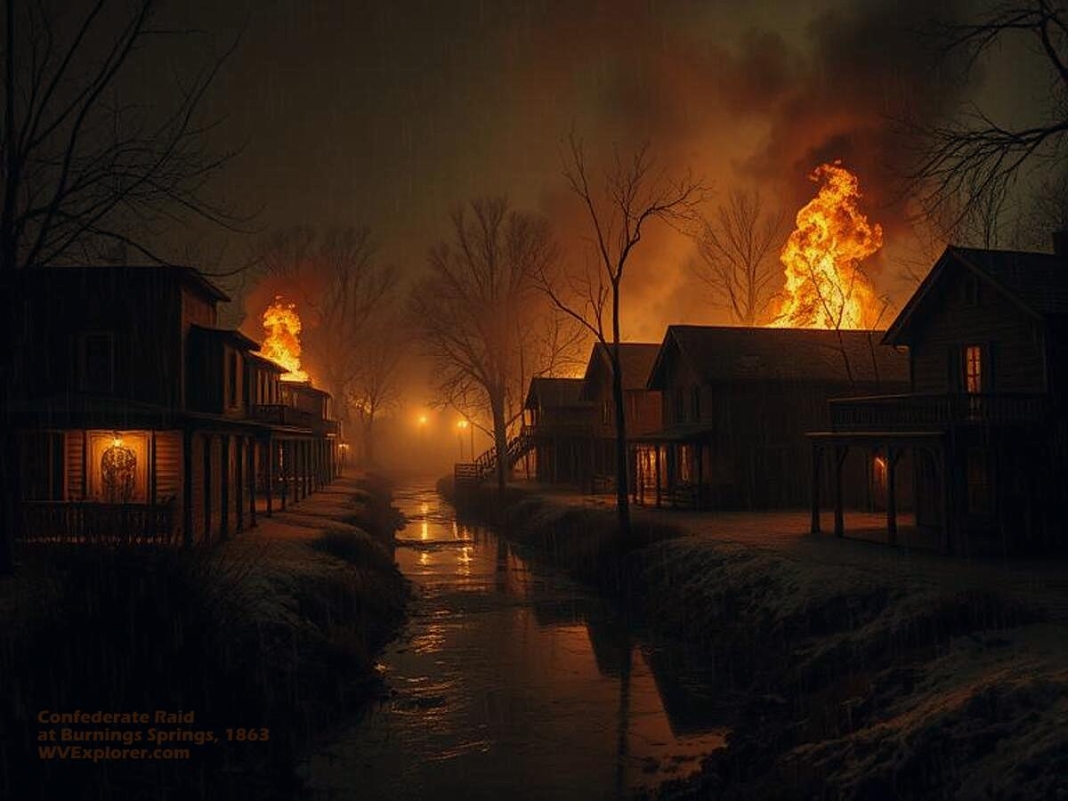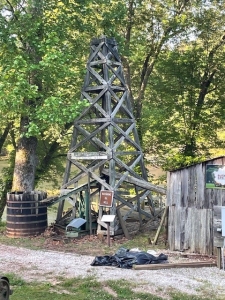BURNING SPRINGS, W.Va. — On the night of May 9, 1863, a conflagration lit up the skies along the Little Kanawha River at Burning Springs at the site of the famous Rathbone Well, the first major oil well in West Virginia.
As part of a Confederate initiative to injure the Union, Brigadier General William “Grumble” Jones had ordered his troops to set the oilfields on fire. Oil spilled into the river, carrying the flames eight miles downstream. Newspapers of the time reported that the fire was visible from 40 miles away in Parkersburg, West Virginia.
The Rathbone Well, which had been drilled in 1860 to access petroleum, was increasingly in demand for lubricating machinery, including that used on railways. Union General George McClellan recognized the value of the well when he moved into western Virginia in late May of 1861, and sent troops to the location to secure it from local Confederate-allied guerrillas.
Raiders move into what's now central West Virginia
Almost two years later, in April 1863, Confederate brigadier generals Jones and John G. Imboden launched simultaneous raids into western Virginia, creating chaos in their wake for the better part of a month.
One of the objectives of the Jones-Imboden Raid was to disrupt the Baltimore & Ohio Railroad. This critical strategic resource helped keep Union forces in the eastern theater of war supplied with men and resources from the Midwest. They did succeed in destroying many bridges along the line, but these were quickly rebuilt.
Other objectives were political. A successful Confederate raid, they believed, would topple local Unionist governments, disrupt the statehood movement, and open the region for the recruitment of soldiers. Their hopes to “liberate” western Virginians from the pro-Union government were not realized.
The movement toward statehood continued apace with minimal disruption, and Confederate recruitment efforts yielded only about 600 new troops, partially offset by several western Virginia Confederates who deserted when they found themselves close to their homes.
The most significant impact of the Jones-Imboden raids was psychological. Despite being outnumbered by Union forces four to one, the raiders inflicted more than 800 casualties while suffering just 100 of their own, made off with substantial herds of cattle and other valuable resources, and left a path of destruction wherever they went.
Burning Springs becomes a military target
One of the more dramatic moments of the raid occurred at the Rathbone well, called "Oiltown" by some of the soldiers. Jones ordered his men to set fire to the oil derricks and barges along the Little Kanawha River. Rebel cavalryman John Opie described what happened:
“When we arrived at this place, we found much oil and whiskey; when we left, there was neither oil nor whiskey there. The two most combustible fluids known to science are coal oil and corn whiskey. The men were ordered to destroy both of these useful fluids, as they were considered contraband goods. This they did in the usual way—they drank the whiskey and fired the oil.”
In his official report on the raid, Jones wrote, “The boats, filled with oil in bulk, burst with a report almost equaling artillery, and spread the burning fluid over the river. Before night, huge columns of ebony smoke marked the meanderings of the stream as far as the eye could reach. By dark, the oil from the tanks on the burning creek had reached the river, and the whole stream became a sheet of fire. A burning river, carrying destruction to our merciless enemy, was a scene of magnificence that might well carry joy to every patriotic heart.”
Fiery demons, dancing upon the surface of the river
The scene was something John Opie would never forget, recalling “great pillars of flame, resembling pyramids of fire, rose to a prodigious height in the air from the burning wells, lighting the surrounding country for miles.
"These pillars, or pyramids, of flame, after ascending separately some distance in the air, seemed to unite in one great sheet of fire, and it looked as though the firmament was one vast conflagration. This appalling and supernatural spectacle was beyond conception or description. It was, in appearance, the flames of an expiring world, and I believe that the men would have so considered it, but for the fact that it was of their own creation."
"The fire also extended to the river, which was soon enveloped in flames, containing many colored lights. The current carried the flames over the water-falls, producing the most fantastic shapes and figures, resembling fiery demons, dancing upon the surface of the river, ever and anon disappearing in the darkness and again appearing, when on a line with one’s vision. The men were greatly relieved when we left this scene of desolation, and many a man that night dreamed of h-ll and of a personal devil.”
The Rathbone well is located in Wirt County. From the town of Elizabeth, West Virginia, follow WV-5 east about eight miles to the site.
Sign up to receive a FREE copy of the West Virginia Explorer Magazine newsletter in your weekly email. Sign me up!




The soldiers who deserted from the Jones-Imboden raid were not West Virginians, they were from eastern Virginia and South Carolina. The only West Virginia company from that regiment was from Jackson County, Co. E, commanded by Edgar Phelps, and they remained with Jones-Imboden and did not desert.